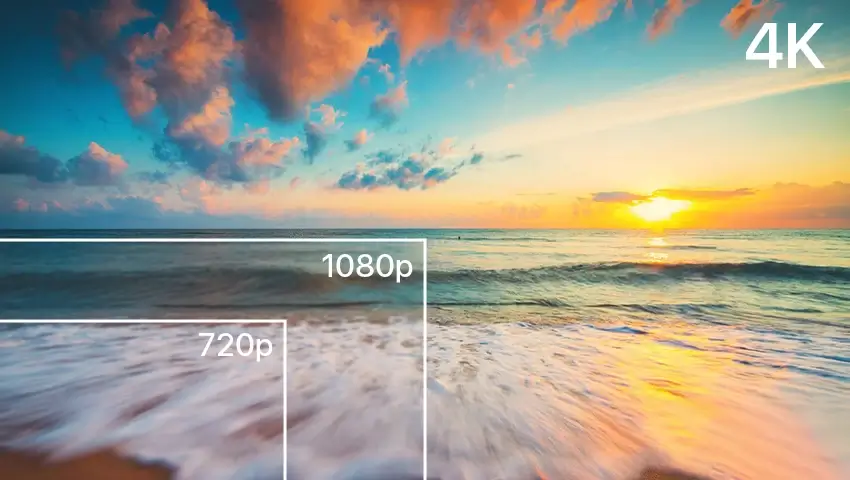In the ever-evolving world of digital media, one term has become synonymous with high-definition clarity: 1080p resolution. It’s the standard that has set the benchmark for visual quality in everything from streaming movies to online gaming. But what exactly is 1080p, and why has it become so prevalent? This blog post will explore the intricacies of 1080p resolution, its benefits, and its role in the future of digital content.
Contents
What is 1080p resolution?
1080p resolution, often referred to as Full HD, is a display resolution that offers a pixel count of 1920 by 1080. The “1080” refers to the number of vertical lines (or rows of pixels), while the “p” stands for progressive scan, meaning the image is drawn in a single pass, from top to bottom. This results in a smoother image compared to interlaced video, where the image is drawn in two passes, which can cause a flickering effect. The pixel dimensions of 1920×1080 provide a wide aspect ratio of 16:9, which is ideal for modern widescreen displays.
When compared to 720p, which has 1280 by 720 pixels, 1080p offers a significant upgrade in detail and clarity. While 720p is still considered high definition, 1080p provides a more immersive viewing experience, especially on larger screens. On the other hand, 4K resolution, which has 3840 by 2160 pixels, is four times the resolution of 1080p, offering even greater detail but also requiring more bandwidth and storage.
The Benefits of 1080p resolution
1. What makes 1080p the preferred choice for many content creators?
1080p strikes a balance between quality and practicality. It offers a high level of detail that is suitable for most screens and devices, without the massive file sizes associated with 4K content. This makes it more accessible for streaming and downloading, ensuring that viewers can enjoy high-quality content without excessive buffering or long download times. Additionally, 1080p is widely supported across various platforms, making it a versatile choice for content that needs to reach a broad audience.
2. How does 1080p enhance the viewing experience?
1080p resolution significantly enhances the viewing experience by providing sharper images and more vibrant colors. This is particularly noticeable when watching high-quality videos, playing graphic-intensive games, or viewing detailed photographs. The increased pixel count allows for finer details to be visible, and the progressive scan technology ensures that motion appears smooth and natural. For many, 1080p offers the perfect balance between visual fidelity and system requirements.
Applications of 1080p resolution
1080p resolution has become the backbone of many industries that rely on high-quality visuals. In streaming services, 1080p is often the default setting for HD content, providing a clear and enjoyable viewing experience for subscribers. Gaming consoles and PC games also leverage 1080p to deliver immersive and detailed gameplay, enhancing the overall gaming experience.
In the world of video production, 1080p is a standard for capturing and editing high-quality footage. It allows for flexibility in post-production, with the ability to crop or zoom without a significant loss in quality. This resolution is also widely supported across various devices, from smartphones to large-screen TVs, ensuring that content can be viewed consistently across different platforms.
The Future of 1080p resolution
While the emergence of 4K and 8K technologies has introduced even higher resolutions to the market, 1080p remains a relevant standard. 4K, with its significantly higher pixel count, offers unparalleled detail and clarity but requires more powerful hardware and faster internet connections to stream or download content. This makes 1080p a more practical choice for many users, especially in regions where high-speed internet is not widely available or where device capabilities are limited.
The transition to 4K and 8K will likely be gradual, with 1080p continuing to serve as a standard for everyday use. As technology advances and becomes more affordable, we may see a shift towards higher resolutions, but for now, 1080p remains a reliable and widely accepted standard.
Maximizing 1080p Performance
To fully enjoy the benefits of 1080p content, it’s essential to have the right display. A screen with a native resolution of at least 1080p is ideal, as it can display the content without downscaling. Additionally, ensuring that your device’s graphics settings are optimized for 1080p can help to maximize the visual quality.
Video encoding and bitrate also play crucial roles in the 1080p experience. A higher bitrate can provide better image quality, but it also requires more bandwidth. For streaming, a bitrate of around 8 Mbps is recommended for 1080p content, but this can be adjusted based on the viewer’s internet speed and the platform’s capabilities.
Conclusion
In conclusion, 1080p resolution has established itself as a key player in the digital media landscape. It offers a balance of quality and accessibility that makes it suitable for a wide range of applications, from streaming to gaming and video production. While the allure of 4K and 8K is undeniable, 1080p continues to hold its ground as a practical and widely accepted standard.
As technology evolves, it’s essential to stay informed about the latest developments in resolution technology. However, for now, 1080p remains a reliable choice for enjoying high-definition content without the need for excessive resources. Whether you’re a content creator looking to reach a broad audience or a consumer seeking the best balance of quality and performance, 1080p continues to deliver clarity at your fingertips.

